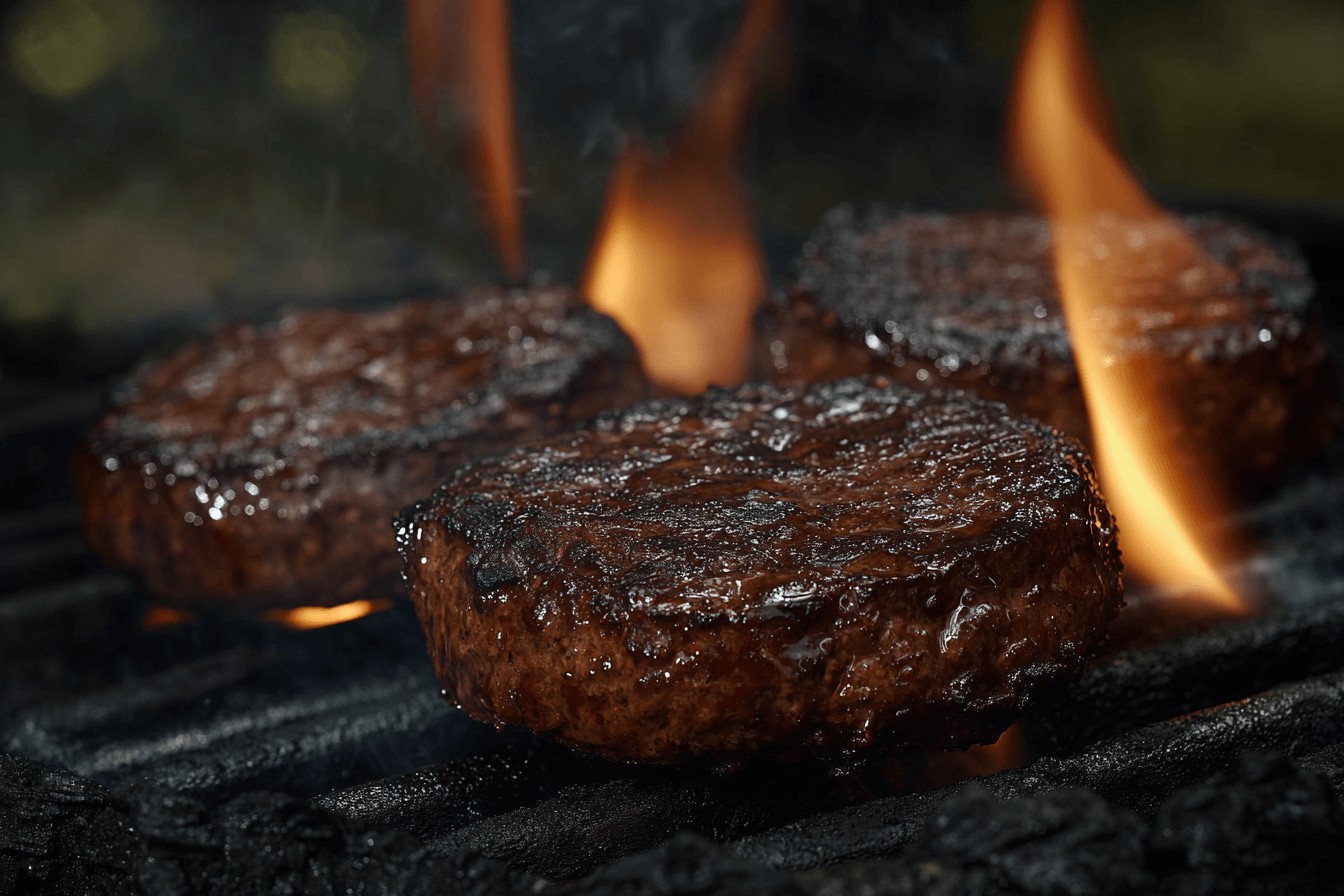Introduction
Burgers are a classic favorite in the United States and around the world. They are satisfying, versatile, and fun to cook at home. However, when you are preparing homemade burgers, you might ask yourself, “Should you add anything to ground beef for burgers?” This question can spark a lively debate among cooking enthusiasts. Some argue that simple seasoning is enough, while others believe in boosting flavor with extra ingredients. There is no single right or wrong approach, yet there are tips you can follow to guide you toward a tasty burger patty.
In many kitchens, ground beef is the star when making burgers. It offers a rich flavor, a juicy bite, and a texture that pairs perfectly with buns, cheese, and condiments. Yet, not all ground beef is created equal. Differences in fat content, freshness, and even the way the meat is handled can affect the final result. In fact, a few small changes in preparation can enhance your burger experience.
Moreover, we often overlook the role of simple add-ins like onions, spices, and sauces. These ingredients can boost taste in subtle ways. On the other hand, overloading your burger with too many items can lead to crumbling or an overpowering flavor. Therefore, finding the right balance is key.
Additionally, cooking techniques matter as much as seasonings. Pan-frying, grilling, or broiling each deliver different textures and levels of browning. So, it helps to think about not only what you put into the burger patty but also how you cook it. This article will walk you through the pros and cons of adding extra ingredients to your ground beef. It will also guide you on how to craft a simple yet tasty burger that is neither bland nor overpowered by too many flavors. Keep reading to learn if you should add anything to ground beef for burgers, what happens when you do, and how to avoid common mistakes.
Should You Add Anything to Ground Beef for Burgers?
When you first consider making burgers, you may wonder if you need to add binders, spices, or other extras to the meat. Often, classic burger purists insist on seasoning with just salt and pepper. They argue that this pure approach allows the flavor of the beef to stand out. Indeed, many high-end steakhouses embrace this minimal method. They rely on high-quality beef and simple seasoning, believing the meat can speak for itself.
However, there are reasons you might want to enhance ground beef. If your meat is quite lean, you could face dryness. Adding small amounts of moisture, such as a splash of Worcestershire sauce or even a bit of plain yogurt, may help keep your burger moist. Furthermore, some cooks add finely chopped onion. The onion releases its juices during cooking, adding both flavor and moisture. Additionally, using spices or herbs can create unique variations. A pinch of garlic powder, paprika, or even dried oregano brings a new dimension to a basic patty.
Still, the question remains: Is it always wise to include add-ins? The answer often depends on preference. If you are aiming for a pure, beef-forward taste, then salt and pepper might suffice. But if you want to experiment or if your ground beef is not very fatty, mixing in certain ingredients can boost the final result. Keep in mind, though, to avoid overwhelming the meat with too many items. Short sentences, recognizable flavors, and just enough moisture can help you achieve a better patty. On the contrary, adding large chunks or lots of fillers can harm the texture.
Moreover, you should also think about how you plan to cook your burgers. Grilling can cause moisture loss, so a small addition of sauce or grated cheese can help keep your patty juicy. Pan-frying might retain more natural fats, so you could skip extra binders in that scenario. As you decide, remember that you are the one eating the burger. If you enjoy onion, garlic, or even diced peppers, you can add them with care and see how the result suits your taste. Try different methods to find your ideal mix.
What to Add to Ground Beef for Burgers
If you have decided that you do want to add something to your burger patties, you may be unsure about the best choice. The options are wide, but let’s focus on a few tried-and-true ideas:

Simple Seasonings
Salt is the number one seasoning you should add to ground beef for burgers. It amplifies the natural flavors of the meat. A light sprinkle of freshly ground black pepper also improves taste without overshadowing the beef. Many people prefer to season at the last moment. However, you can mix salt and pepper into the ground beef if you like. Just do not overmix the meat, as that can toughen your burger.
Beyond salt and pepper, consider onion powder or garlic powder. These help bring out savory notes. Additionally, you might add a pinch of paprika for a gentle smoky taste. Try to keep spice additions modest, so the burger still tastes like beef.
Savory Sauces
Worcestershire sauce is a popular choice if you want a boost of umami flavor. This sauce blends well with ground beef, giving a deeper taste without leaving a strong sauce-like feel. Soy sauce is another option that can bring salty richness. Moreover, a small spoonful of mustard can provide a tangy edge, especially if you like a bit of zing.
When adding sauces, use small amounts to avoid making the beef too wet. You can try mixing a teaspoon of sauce per pound of ground beef. Then, adjust to your liking.
Aromatic Vegetables
Onion, garlic, and peppers can boost taste if chopped very finely. Furthermore, these vegetables release juice as they cook, so they can keep your patty from drying out. Some people sauté onions and peppers before mixing them in. This step softens their texture and releases sweetness. Others add them raw for a sharper flavor. Either approach can work, though raw veggies will make the texture chunkier.
If you use onions, pick a mild variety, like a sweet onion or a yellow onion, to avoid too much pungency. Additionally, you could try green onions or shallots for a milder taste.
Binders and Fillers
Sometimes, home cooks worry about their burgers falling apart on the grill. One remedy might be to mix in an egg. While eggs can help hold ground beef together, not everyone likes the added flavor or texture. Breadcrumbs are another filler that can reduce shrinkage and add structure. However, they also dilute the beefiness of your burger. If you choose breadcrumbs, go for a small amount and use fresh breadcrumbs rather than dry, boxed crumbs.
On the other hand, if you pick a ground beef blend with higher fat content, you might not need a binder at all. Fat adds natural moisture and helps hold the patty together. Therefore, choose your ground beef wisely. Many people prefer an 80/20 ratio of meat to fat for a perfect balance.
Cheesy Twists
Cheese is a staple topping for burgers. Yet, you can also add grated cheese directly into your patties for extra flavor and moisture. For example, cheddar, gouda, or pepper jack can melt into the beef, offering a gooey surprise. However, do not go overboard, or your patty might leak melted cheese, causing flare-ups on the grill. A small handful of grated cheese per pound of meat is often enough to enhance taste without losing structure.
The Best Techniques for Mixing and Shaping
Once you decide what to add to ground beef for burgers, the next question is how to combine everything. Indeed, your mixing technique can shape the final texture of your burger.

Gentle Mixing
When you mix ground beef with salt, pepper, and other ingredients, do so gently. Overmixing can result in a dense patty. The goal is to keep the beef fibers loose and airy. Furthermore, a light mix helps prevent the proteins from binding too tightly. Many chefs suggest using your hands to combine ingredients. This allows you to feel the texture and avoid applying too much force.
Additionally, consider chilling your mixing bowl and ingredients. Cold beef is less prone to smearing, which leads to less toughening. Keep things cool, then form your patties right before cooking. This method also helps reduce the risk of bacteria growth from leaving raw meat out too long.
Consistent Patty Size
Try to form your patties so that they are all about the same size and thickness. This ensures even cooking. If one patty is much thicker than another, it will not cook at the same rate. A thickness of about three-quarters of an inch is often a good starting point.
Moreover, make a small dimple in the center of the patty with your thumb. This shallow indentation helps the patty cook flat instead of puffing up. It also aids in even cooking from the center outward. By using consistent shapes, you reduce the chance of undercooked or overcooked spots.
Avoid Tight Packing
Press your patties just enough to hold them together. But avoid packing them so hard that they become solid lumps of meat. Tightly packed ground beef can make a dry burger. Instead, form the patty gently, letting small air pockets remain. This approach leads to a juicier and more tender bite once cooked.
Cooking Tips for Perfect Burgers
Even if you have chosen whether to add anything to your burger patties or not, your cooking method can make or break the final product. Whether you grill, pan-fry, or broil, a few key details can elevate your burger from average to mouthwatering.
Grilling
Grilling is a popular method in the U.S. and for good reason. The open flame imparts a smoky flavor, and the high heat creates a crisp exterior. Preheat your grill to medium-high heat to ensure the surface is hot enough to sear the meat.
Before placing your patties on the grill, lightly oil the grates to prevent sticking. Once the burgers start cooking, resist the urge to press them down with a spatula. Pressing causes precious juices to drip out, leading to a dry patty. Flip the burgers only once or twice. Over-flipping can affect browning and taste.
Furthermore, watch for flare-ups caused by dripping fat. Move your burgers away from high flames if needed, or adjust the heat. For doneness, use a meat thermometer. A reading of 160°F (71°C) at the center ensures a well-done burger that is safe to eat, according to USDA guidelines.
Pan-Frying
Pan-frying in a skillet is a reliable way to cook burgers at home. The pan helps lock in juices and promotes an even crust across the patty. Cast-iron skillets are favored because they maintain steady heat. However, a nonstick pan can also work well.
Begin by heating a small amount of oil or butter in the skillet over medium-high heat. Once hot, add your patties. Cook them for about 3-4 minutes on each side, depending on thickness and desired doneness. Additionally, you can tilt the pan and spoon some of the rendered fat over the burger as it cooks. This quick basting adds flavor and moisture. But keep in mind that you should not overcook the burger or press it with a spatula.
Broiling
If you do not have a grill, broiling in the oven is another way to achieve a crispy outer layer. Position your oven rack so the burgers will be a few inches below the broiler. Preheat the broiler until it’s quite hot. Place the patties on a broiler pan or a wire rack set on a baking sheet, which allows the fat to drain.
Watch the burgers closely, as broiling can cause rapid browning and even charring. Flip them once the top is nicely browned. Keep an eye on internal temperature, and remove them when they reach your desired doneness. Again, 160°F (71°C) is recommended for safety.
Serving Suggestions and Extra Flavor Boosts
Your burger experience extends beyond the patty itself. While the question remains “Should you add anything to ground beef for burgers,” you also want to consider the final presentation.

Toppings and Condiments
Classic burger toppings include lettuce, tomatoes, onions, pickles, and cheese. You can also get creative with avocado slices, sautéed mushrooms, or caramelized onions. Furthermore, sauces like ketchup, mustard, mayonnaise, or special burger sauce complete the flavor. Pick sauces and toppings that complement your patty’s seasonings. If your patty is rich and savory, a bright, tangy sauce can balance it out.
Bun Choices
The bun is more important than you might think. A sturdy bun can handle the juices without falling apart. Popular options include brioche buns, potato rolls, or pretzel buns. Toasting or lightly grilling the buns adds a crisp layer and helps keep them from becoming soggy. Moreover, you can spread a thin layer of butter or mayo on the cut side of the bun before toasting. This trick not only improves flavor but also acts as a moisture barrier.
Side Dishes
Fries are the classic side, but why not branch out? You could serve sweet potato fries, onion rings, or a simple green salad to balance the richness. Grilled corn on the cob, coleslaw, or roasted vegetables are also tasty accompaniments. Additionally, these sides can lighten the meal, especially if you have a heavy burger with cheese or sauce mixed into the meat.
Pairing Drinks
Though it might seem like an afterthought, drinks play a role in your burger enjoyment. A cold soda or iced tea can refresh your palate. If you enjoy alcoholic beverages, a pale ale or a hoppy IPA pairs well with a savory burger. For a more mellow option, try a fruity wheat beer or a light lager. Wine drinkers might prefer a medium-bodied red, such as a Merlot, to match the burger’s hearty flavor.
Frequently Asked Questions
What does Gordon Ramsay put in his burger patty?
Gordon Ramsay often seasons his burger patties with salt, pepper, and sometimes garlic powder. He may also brush the patties with butter or oil during cooking for extra flavor. However, he keeps the meat mixture simple to let the beef shine.
Do you mix egg with ground beef for burgers?
Many people do, yet it is not always necessary. Adding egg can act as a binder, helping the patty hold together, especially if the beef is very lean. But if you use ground beef with enough fat, you can skip the egg.
Should I add anything to my burger patties?
That depends on your taste and the fat content of the meat. Some folks prefer a simple approach with only salt and pepper. Others like to mix in onion, garlic, or sauces like Worcestershire. If you like these flavors, feel free to add them.
What should I add to my ground beef for burgers?
A pinch of salt and pepper is vital. For more flavor, try onion or garlic powder, or a dash of soy sauce. Keep additions light so they do not overpower the beef.
Conclusion
When it comes to making your ideal burger, there is no single right answer to the question, “Should you add anything to ground beef for burgers?” The key is finding the balance that fits your taste. If you love classic flavor, keep it simple with salt and pepper. If you crave an extra kick, try adding a small amount of onion, garlic, or savory sauce. Moreover, pay close attention to how you shape and cook your patties. Gentle mixing and proper heat management can mean the difference between a dry burger and one that is juicy and flavorful. Above all, enjoy the process. There is no harm in experimenting with different additions until you discover your preferred style. Good luck on your next burger adventure and savor every bite!

